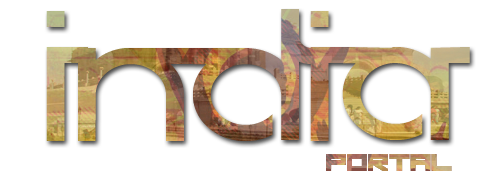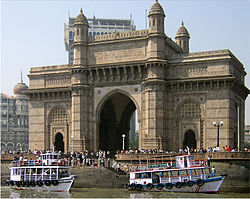- Wikipedia portals: Culture
- Geography
- Health
- History
- Mathematics
- Natural sciences
- People
- Philosophy
- Religion
- Society
- Technology

Related Portals: Atlas · Asia ·
| Main Page |
|
Explore |
|
Unite and perform |
editIndia Portal
The Republic of India is a country that occupies a greater part of the Indian subcontinent. It borders Pakistan in the northwest, the People's Republic of China, Nepal, and Bhutan in the north, and Bangladesh and Myanmar in the east. India's coastline stretches for over seven thousand kilometers. Its neighbours in the Indian Ocean are the island nations of the Maldives in the southwest, Sri Lanka in the south, and Indonesia in the southeast. India is the second most populated country in the world, with a population of over one billion and is the seventh largest country by geographical area. It is a constitutional republic consisting of twenty eight States and seven union territories. The word India derives from the Old Persian cognate for the Sanskrit word Sindhu, the Indus river. The Constitution of India also recognizes Bhārat  listen ( help·info) as an official name with equal status. listen ( help·info) as an official name with equal status.
A centre of important historic trade routes, India is the home to some of the most ancient civilisations. India is the birthplace to four world religions: Buddhism, Jainism, Sikhism and Hinduism. It also has the largest Muslim population in the world after Indonesia and Pakistan. Hinduism is the major religion followed in India. India is a secular country. India was a former colony of the British Empire under the British Raj before gaining independence on 15 August 1947. The country has witnessed significant economic and military growth after the liberalization of the Indian economy. India is also well-known for upholding the concept of peace, as was demonstrated by its peaceful method of freedom struggle.
National Anthem of India
Selected article
Satyajit Ray (May 2, 1921 – April 23, 1992) was an Indian film director, regarded as one of the greatest auteurs of twentieth century cinema for his subtle, austere and lyrical style of film-making. Born in a prominent Bengali family of arts and letters, Ray studied in Kolkata and at the Visva-Bharati University, Shantiniketan. After completing his education, Ray took up visual design, before turning to film direction. Ray's cinematic debut, Pather Panchali (1955) is a milestone of humanist filmmaking and changed the course of Bengali and Indian cinema. Ray directed thirty-seven films, comprising features, documentaries and shorts. Apart from being a film-maker, he was also a fiction writer, publisher, illustrator, graphic designer and film critic. Ray received many major film and movie awards in his career, including an Academy Award for lifetime achievement in 1991 shortly before his death in Kolkata. ( more...)
Selected picture
 |
|
The Gateway of India is a monument located on the waterfront of South Mumbai. Its central dome is a basalt arch, 15 metres in diameter and 26 metres above ground at its highest point. While Indo-Saracenic in architectural style, elements are derived from the Muslim architectural styles of 16th century Gujarat. The Gateway is traditionally the first thing visitors arriving by boat would see of Bombay.
Photo credit: Rhaessner
|
Did you know...
...the number zero was invented in India by Aryabhata, a mathematician and astronomer. ...India got its independence from Britain by entirely nonviolent means. ...5 of the world's major religions orginate from India
Categories
India • Ayurveda • Bollywood • Christianity • Cities and towns • Companies • Economy • Environment • Geography • Government • Health • Hindu temples • History • Indian Antarctic Program • Indology • Islam • Law enforcement • Media • Military • National parks • People • Politics • Social groups • Social history • space programme of India • Tourism • Transport • Universities and colleges • World Heritage Sites in India • India-related stubs
Topics related to India
| History |
Timeline of Indian history, Indus Valley Civilization, Dholavira, Science and technology in ancient India, Meluhha, Aryan invasion theory, Out of India theory, Greek Conquests in India, Indian Ancient Maritime History, Mauryan dynasty, Ashokan Era, Sunga dynasty, Hoysala, Vijayanagara, Satavahana, Indo-Greek kingdom, Indo-Scythians, Indo-Parthian Kingdom, Kushan Empire, Western Kshatrapas, Gupta Empire, Cholas, Pala Empire, Islamic incursions in India, Mughal Era, Maratha Empire, British Raj, British East India Company, Governor-General, Viceroy, War of Independence, 1857, Indian independence movement, Indian National Army, Azad Hind, Quit India Movement, Partition of India, Non-Aligned Movement, Sino-Indian War, Indo-Pakistani War of 1947, Indo-Pakistani War of 1965, Indo-Pakistani War of 1971, Kargil War, 2001 India Pakistan standoff, Military, Demographic |
| Politics |
Law, Hindu law, Constitution, Political parties ( Indian National Congress, Bharatiya Janata Party), Foreign relations, Elections, Political divisions, Reservations in India |
| Government |
Government agencies, Legislative branch ( Lok Sabha, Rajya Sabha) Executive branch ( President & Vice-President, Prime Minister & Deputy Prime Minister, Cabinet Ministers, Attorney-General, Election Commission, Foreign Minister; Law enforcement: CBI, CID, Intelligence: IB, RAW), Directorate General of Income Tax Investigation Judicial branch ( Supreme Court), Military ( Army, Navy, Air Force, Border Security Force, Coast Guard) |
| Geography |
The Himalayas, Western Ghats, Eastern Ghats, Indo Gangetic Plain, Deccan Plateau, Thar Desert, Ganges River, Rann of Kutch, Brahmaputra River, North-East India; Mountains, Valleys, Islands, Rivers; States and territories, Cities, Districts, Regions, Fauna and flora |
| Economy |
Rupee, Bombay Stock Exchange, National Stock Exchange, Standard of living, Companies, Reserve Bank of India, Energy policy ( Solar, Wind, Nuclear) |
| Demographics |
Languages, Standard of living, Religion |
| Arts & Culture |
Music ( Carnatic, Hindustani, Indi-pop), Dance, Languages, Literature, Architecture, Film & TV, Cuisine, Holidays, Folklore, Education, Media, Indian martial arts |
| Science & Tech |
Indian Council of Agricultural Research(ICAR), Indian Institute of Astrophysics, National Centre for Software Technology, AIIMS, IISc, IIT, NIT, BITS-Pilani, INRegistry, Indian numbering system, Indian Space Research Organisation, India Internet Exchange, ICRISAT, International Institute of Information Technology, Hyderabad |
| Other |
Indian English, Indian nationality law, Numbering system, Indian Space Research Organisation, Communications, Transportation ( Highways, Rail transport, Auto rickshaw), National Highways Development Project, Flag, Tourism, Licence plates, Indian nationalism, Metrication in India |
Related portals
Religion: Hinduism • Buddhism • Ayyavazhi • Jainism • Sikhism • Zoroastrianism • Islam • Christianity
Geography: Asia • China • Pakistan • Bhutan • Bengal • Bangladesh • Sri Lanka • Himalaya region
Places: Kerala • Maharashtra • Karnataka • Gujarat • Tamil Nadu • Goa • Uttar Pradesh• West Bengal• Himachal Pradesh • Orissa • Bihar• Andhra Pradesh• Madhya Pradesh
|
|
|
|
|
|
|
|
|
| Ahmedabad |
Bangalore |
Chandigarh |
Chennai |
Delhi |
Hyderabad |
Kolkata |
Mumbai |
Politics: SAARC • Government of India • Sports: Cricket
• Events: Indian independence movement • Transportation: Railways in India
Wikipedias in Indian languages
অসমিয়া (Assamese) • भोजपुरी (Bhojpuri) • বাংলা (Bengali) • ગુજરાતી (Gujarati) • हिन्दी (Hindi) • ಕನ್ನಡ (Kannada) • कॉशुर/كشميري (Kashmiri) • മലയാളം (Malayalam) • मराठी (Marathi) • नेपाली (Nepali) • ଓଡ଼ିଆ (Oriya) • ਪੰਜਾਬੀ (Punjabi) • संस्कृतम् (Sanskrit) • سنڌي (Sindhi) • தமிழ் (Tamil) • తెలుగు (Telugu) • اردو (Urdu)
|
|

